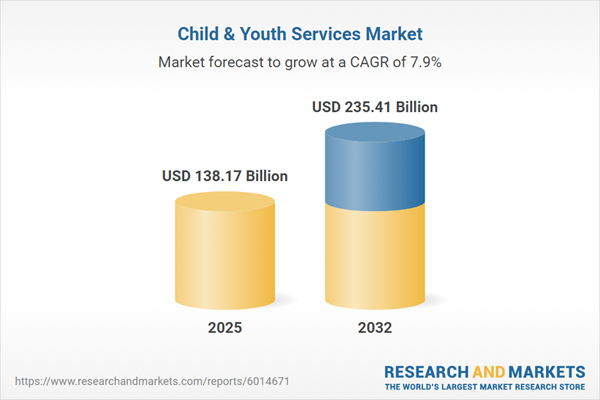Speak directly to the analyst to clarify any post sales queries you may have.
The Child & Youth Services Market is undergoing substantial transformation as organizations adapt to new care models, expanding regulations, and rising expectations. Senior decision-makers require reliable market intelligence to drive growth, manage risk, and enhance outcomes in this shifting landscape.
Market Snapshot: Child & Youth Services Market Growth Trajectory
The global Child & Youth Services Market is displaying robust growth as demand for integrated service delivery rises and technology adoption accelerates across providers. In 2024, the market stands at USD 127.91 billion and is projected to reach USD 138.17 billion by 2025. A compound annual growth rate of 7.92% is set to propel the market to USD 235.41 billion by 2032. Core drivers include the proliferation of technology-enabled care, continuous service innovation, and a strong commitment to meeting the diverse and evolving needs of children and youth worldwide. Strategic investments in compliance frameworks and scalable platforms are equipping organizations to broaden their reach across both public and private sectors.
Scope & Segmentation of the Global Child & Youth Services Market
This report gives senior leaders a comprehensive view of the Child & Youth Services Market by outlining practical segments and highlighting areas for targeted investment. Segmentation ensures that strategic initiatives align with the developmental and operational landscape of the sector, supporting improved resource allocation and market planning.
- Service Type: After school care, daycare and preschool, individual and group counseling, school-based interventions, tutoring, vocational training, prevention initiatives, plus arts, outdoor, and sports programs designed to foster youth participation and skill development.
- Age Group: Differentiated support for infants (0–2 years), toddlers (3–5 years), children (6–12 years), and adolescents (13–18 years), allowing solutions to address unique developmental requirements.
- Delivery Channel: Hybrid, in-person, and online service models tailored to accessibility needs, ensuring families and youth access resources through their preferred channels.
- Funding Source: Analysis of nonprofit, private, and public financing, helping organizations assess impacts on resource management, compliance, and governance.
- Program Duration: Short-term and long-term delivery models, offering flexibility to adjust to changing care demands and support strategic decision-making cycles.
- Geographic Coverage: Market characteristics examined across North America, Latin America, Europe, the Middle East, Africa, and Asia-Pacific, enabling organizations to anticipate regional trends and build effective local partnerships.
- Key Companies Analyzed: Benchmarking among major players such as Bright Horizons Family Solutions, KinderCare Education, Learning Care Group, Childcare Network, Primrose Schools, The Goddard Systems, Kids ‘R’ Kids International, Lightbridge Academy, The Learning Experience Franchise Holdings, and YMCA of the USA to support identification of operational best practices.
Key Takeaways for Senior Decision-Makers
- Adopting integrated care models that unify educational, psychosocial, and wellness support can elevate engagement and improve overall impact for children and youth.
- Technology plays a pivotal role, enabling personalized interventions, enhancing operational flexibility, and streamlining cross-regional service delivery.
- Building synergy across education, health, and technology sectors fuels service innovation, accelerates process standardization, and facilitates the creation of scalable solutions.
- Implementing adaptive operational frameworks equips organizations to navigate changing regulations, onboard digital solutions, and optimize financial resources under varying funding environments.
- Maintaining strong data transparency and rigorous performance measurement strengthens stakeholder confidence, supports funding sustainability, and aligns services to evolving market demands.
Tariff Impact: Navigating Cost Pressures
Recent tariff changes in the United States affecting educational materials and specialist supplies have raised operational costs for many providers reliant on imported goods. Organizations are responding through increased domestic sourcing, leveraging cooperative procurement, and diversifying supplier partnerships to safeguard service standards and minimize supply chain disruptions.
Methodology & Data Sources
Market insights are based on quantitative data from more than 500 global providers alongside in-depth interviews with senior sector leaders. The methodology integrates benchmarking against validated government and industry sources, ensuring that findings reliably reflect present opportunities, risks, and regional variances critical for executive planning.
Why This Report Matters
- Delivers frameworks enabling leadership to design growth-oriented strategies, prioritize resource deployment, and guide informed investment within the Child & Youth Services Market.
- Equips organizations to manage risk and respond to regulatory changes, promoting continued service quality and workforce stability as market conditions evolve.
- Establishes clear benchmarks for operational performance, hybrid service adoption, and constructive cross-sector partnerships supporting future market resilience.
Conclusion: Strategic Roadmap for Growth and Resilience
Adopting flexible operating models and advanced technologies will position organizations to respond effectively to industry shifts. This report supports strategic planning, helping stakeholders enhance their capacity and deliver consistent long-term impact.
Additional Product Information:
- Purchase of this report includes 1 year online access with quarterly updates.
- This report can be updated on request. Please contact our Customer Experience team using the Ask a Question widget on our website.
Table of Contents
3. Executive Summary
4. Market Overview
7. Cumulative Impact of Artificial Intelligence 2025
Companies Mentioned
The companies profiled in this Child & Youth Services market report include:- Bright Horizons Family Solutions, Inc.
- KinderCare Education, LLC
- Learning Care Group, LLC
- Childcare Network, Inc.
- Primrose Schools, LLC
- The Goddard Systems, Inc.
- Kids ‘R' Kids International, Inc.
- Lightbridge Academy, LLC
- The Learning Experience Franchise Holdings, LLC
- YMCA of the USA
Table Information
| Report Attribute | Details |
|---|---|
| No. of Pages | 191 |
| Published | November 2025 |
| Forecast Period | 2025 - 2032 |
| Estimated Market Value ( USD | $ 138.17 Billion |
| Forecasted Market Value ( USD | $ 235.41 Billion |
| Compound Annual Growth Rate | 7.9% |
| Regions Covered | Global |
| No. of Companies Mentioned | 11 |









